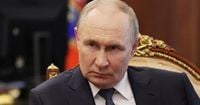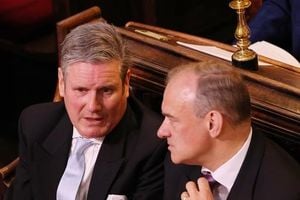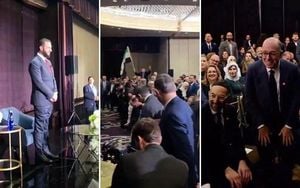In a series of events that have shaken the security architecture of Eastern Europe, Estonia became the latest NATO member to suffer a direct airspace violation by Russian military aircraft—a move that has triggered emergency meetings at the highest levels of international diplomacy and raised the specter of broader confrontation between Moscow and the Western alliance.
On September 19, 2025, three Russian MiG-31 'Foxhound' fighter jets entered Estonian airspace without authorization, remaining for a striking twelve minutes over the Gulf of Finland. According to the Estonian government, the Russian aircraft crossed from the northeast and were initially intercepted by Finnish jets. Once inside Estonian airspace, the situation escalated: Italian Air Force F-35s, deployed at Ämari Air Base as part of NATO’s Baltic Air Policing mission, scrambled to escort the intruders out. The Estonian government reported that the Russian planes had no flight plans, flew with their transponders switched off, and failed to establish two-way radio communication with Estonian air traffic control—an unprecedented breach in both duration and audacity for the small Baltic nation.
This incident marked Estonia as the third NATO country in just ten days to suffer an airspace violation by Russian forces. Earlier in September, Poland experienced a barrage of nineteen Russian drone incursions during a heavy air raid on Ukraine, prompting Warsaw to invoke NATO’s Article 4—a clause that allows any member to bring security concerns to the North Atlantic Council. Romania, too, reported a violation by a Russian Geran drone on September 13. The sequence of events left NATO allies on edge, with many seeing a deliberate Russian campaign designed to probe and test the alliance’s eastern defenses.
In response to these provocations, NATO launched its 'Eastern Sentry' mission on September 12, 2025. According to NATO’s official website, the operation brings together a mix of traditional and novel military assets, including advanced technologies specifically aimed at countering the threat posed by drones. NATO Secretary General Mark Rutte described the alliance’s response as “quick and decisive,” underscoring the seriousness with which the incursion was treated.
Estonian Prime Minister Kristen Michal didn’t mince words in her assessment of Russia’s intentions. As reported by the Estonian government, Michal stated, “the aim is to draw attention and assistance away from Ukraine by forcing NATO countries to focus more on the defence of their own territories.” Echoing this concern, Estonian Defence Minister Hanno Pevkur emphasized the increasing aggressiveness of Russia toward NATO’s eastern flank, noting, “NATO’s defence mechanisms worked. The Alliance responded decisively, with Italian fighters stationed in Estonia scrambling immediately and forcing the intruders out of Estonian airspace. This incident underscores the importance of NATO’s recently launched vigilance measure Eastern Sentry, which must strengthen Allied air defence across the entire eastern flank.”
Estonian Foreign Minister Margus Tsahkna, in a statement on Sunday ahead of an emergency United Nations Security Council meeting, called the incursion “unprecedentedly brazen” and warned that Russia’s actions “undermine principles that are essential to the security of all UN member states,” as quoted by Axios. Tsahkna called for a “swift increase in political and economic pressure” to counter Russia’s “increasingly extensive” boundary testing and aggressiveness. In a separate interview with the BBC, Tsahkna described the incident as “a very clear provocation; it was definitely meant like this.”
Not surprisingly, the Kremlin has flatly denied any wrongdoing. Russian Ministry of Defense officials insisted their aircraft complied with international regulations, and Kremlin spokesman Dmitry Peskov dismissed Estonia’s claims as “empty, unfounded and a continuation of the country’s utterly unstoppable policy of escalating tensions and provoking a confrontational atmosphere.” This rhetoric has done little to calm nerves in the region or among NATO’s leadership, who see a pattern of deliberate escalation.
The gravity of the situation prompted Estonia to invoke NATO’s Article 4, making it the second alliance member to do so in the wake of Russian airspace violations this month. The matter quickly reached the United Nations, where the Security Council convened an emergency session on September 22, 2025, at Estonia’s request. U.S. Ambassador Mike Walz told the meeting, “the impression [is] either Russia wants to escalate or doesn’t have full control of its fighter planes and drones. Either scenario… is very disconcerting.”
British Foreign Minister Yvette Cooper joined the chorus of warnings, stating that Russia’s incursions “risk direct armed confrontation between NATO and Russia. Our alliance is defensive but be under no illusion we stand ready to defend NATO’s skies and NATO’s territory. If we need to confront planes operating in NATO space without permission then we will do so.”
European leaders, particularly those in NATO’s so-called “front-line” states, are treating the threat as immediate and grave. Estonia has begun digging anti-tank trenches along its border with Russia, a measure that underscores the seriousness with which Tallinn views the risk of further escalation. Latvian President Edgars Rinkevics commented that Russia is “doing just enough not to cross a red line,” but warned that hesitation could embolden Moscow further. As reported by NBC News, analysts like Moritz Brake of the Center for Advanced Security, Strategic and Integration Studies argue that “wavering is much more dangerous than a forceful approach.”
Calls for a tougher response have grown louder. Czech President Petr Pavel, a former chair of NATO’s Military Committee, urged the alliance to consider shooting down Russian jets if violations continue. Lithuanian Defence Minister Dovilė Šakalienė pointed to Turkey’s 2015 downing of a Russian warplane as a precedent, recalling that Moscow did not retaliate militarily at the time. U.S. President Donald Trump, when asked by reporters whether Washington would defend Poland and the Baltic states in the event of further Russian aggression, responded, “Yeah I would,” but his administration’s overall response has been seen as more muted compared to the urgent calls from European capitals.
Meanwhile, Ukrainian President Volodymyr Zelensky has called for a “systematic response” to what he described as “a systematic Russian campaign directed against Europe, against NATO, against the West.” Ukraine, itself under constant assault, has requested to attend the Security Council meeting to present its position.
The recent spate of Russian incursions has revived memories of a dangerous precedent: in November 2015, a Russian Su-24M violated Turkish airspace and was shot down by a Turkish F-16 after ignoring repeated warnings. The incident did not lead to outright war, but it did mark a significant escalation in NATO-Russia tensions.
With Russian military aircraft and drones now testing the boundaries of NATO’s eastern frontier, the alliance faces a critical decision point. Will it respond with the force and unity its leaders promise, or will hesitation invite further, riskier provocations from Moscow? As the Security Council meets and NATO’s Eastern Sentry mission continues apace, the world watches, well aware that the stakes have not been this high in years.







